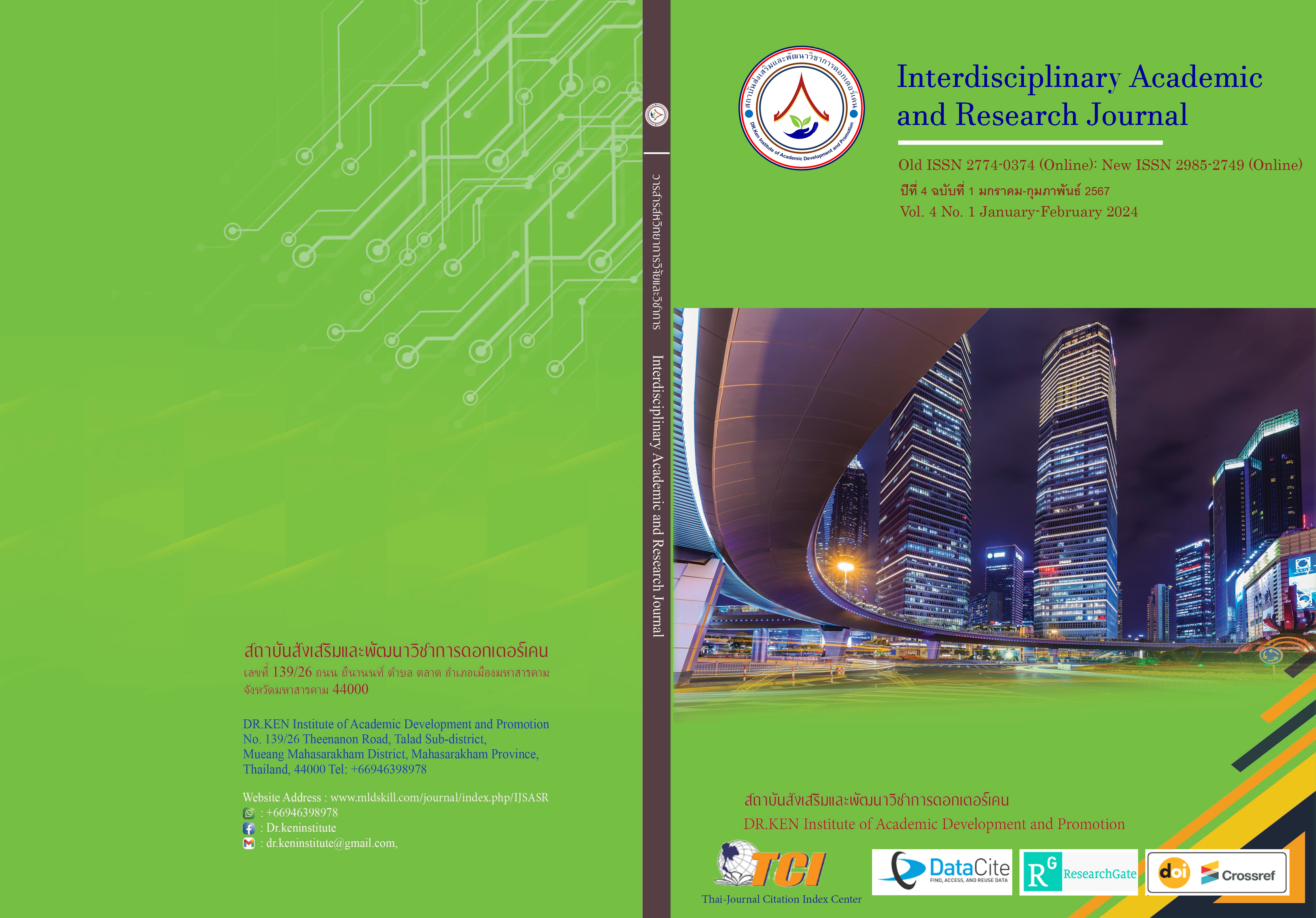Development of Teaching Methods to Promote Critical Thinking Skills and Scientific Concepts of Students Mathayom 1
DOI:
https://doi.org/10.60027/iarj.2024.273178Keywords:
Critical Thinking Skills; , Scientific Concepts; , Phibun Mangsahan SchoolAbstract
Background and Aims: Science teaching has an important goal, which is to make students understand the principles and theories that are the basis of science so that students have knowledge and understanding about the nature of science, and technology that can be used to benefit themselves and society. The objectives of this research are: (1) developing an instructional model to promote critical thinking skills and scientific concepts. (2) Studying the results of using an instructional model to promote critical thinking skills and scientific concepts. And (3) to evaluate the development of teaching models to promote critical thinking skills and scientific concepts.
Methodology: The research process is divided into 4 phases: Phase 1 Study of basic information on science learning management concepts. Theories related to scientific concepts teaching and learning management and critical thinking skills. Phase 2 Developing a teaching model to promote critical thinking skills and scientific concepts of Mathayom 1 students. Phase 3 Experiment with teaching methods to promote critical thinking skills and scientific concepts of Mathayom 1 students. Phase 4 Evaluating the development of teaching models to promote critical thinking skills and scientific concepts of Mathayom 1 students. The sample group consisted of 40 Mathayom 1 students at Phibun Mangsahan School, Ubon Ratchathani Provincial Administrative Organization. The tools used to collect data include a teaching model to promote critical thinking skills and scientific concepts of Mathayom 1 students, a science concept scale, a critical thinking skills test, and a learning satisfaction measure. Statistics used in data analysis include mean, percentage, standard deviation, and t-test statistics.
Results: Teaching model to promote critical thinking skills and scientific concepts. It was found that the results of the evaluation of the suitability of the model had a mean of 4.43 and a standard deviation of 0.49, which is at a high level of appropriateness. (2) Using an instructional model to promote critical thinking skills and scientific concepts makes students have higher critical thinking skills after studying than before, at a statistical significance of .05. Students' science concepts after studying were higher than before studying at a statistical significance of .05. And students are satisfied with learning at a high level. (3) Results of the evaluation of the development of teaching models to promote critical thinking skills and scientific concepts. Overall, teachers' opinions were at the highest level.
Conclusion: it was found that using a teaching model that promotes critical thinking skills and scientific concepts has good results with a high mean of appropriateness. And students who use this model have higher critical thinking skills and scientific concepts. Increase satisfaction in learning. The teachers had very high opinions about the development of this teaching model at the highest level.
References
กระทรวงศึกษาธิการ. (2559). สภาวการณ์การศึกษาไทยในเวทีโลก พ.ศ. 2559. กรุงเทพฯ: พริกหวานกราฟฟิค.
ชัยวัฒน์ สุทธิรัตน์. (2552). 80 นวัตกรรมการจัดการเรียนรู้ที่เน้นผู้เรียนเป็นสำคัญ. กรุงเทพฯ:แดเน็กซ์ อินเตอร์คอร์ปอเรชั่น.
ทิศนา แขมมณี. (2548). รูปแบบการเรียนการสอน: ทางเลือกที่หลากหลาย. กรุงเทพฯ: จุฬาลงกรณ์ มหาวิทยาลัย.
ทิศนา แขมมณี. (2551). 14 วิธีสอนสำหรับครูมืออาชีพ. กรุงเทพฯ: สำนักพิมพ์แห่งจุฬาลงกรณ์มหาวิทยาลัย.
ทิศนา แขมมณี. (2558). ศาสตร์การสอนองค์ความรู้เพื่อการจัดการกระบวนการเรียนรู้ที่มีประสิทธิภาพ.พิมพ์ครั้งที่ 19. กรุงเทพฯ : จุฬาลงกรณ์มหาวิทยาลัย.
บรรจง อมรชีวิน. (2556). การคิดอย่างมีวิจารณญาณ : หลักการพัฒนาการคิดอย่างมีตรรกะเหตุผลและดุลยพินิจ. กรุงเทพมหานคร: สถาบันการคิดอย่างมีวิจารณญาณ.
บุญชม ศรีสะอาด. (2550). วิธีการทางสถิติสําหรับการวิจัยเลม 1. กรงเทพฯ : สุวิริยาสาส์น.
พงศ์รัตน์ ธรรมชาติ. (2564). การพัฒนารูปแบบการสอน เพื่อส่งเสริมการคิดอย่างมีวิจารณญาณและผลสัมฤทธิ์ทางการเรียนวิชาเคมีหน่วยการเรียนรู้ พันธะเคมีสำหรับนักเรียนชั้นมัธยมศึกษาปีที่ 4. วารสารมหาจุฬานาครทรรศน์, 8(2), 89-103.
พิมพันธ์ เดชะคุปต์. (2545). พฤติกรรมการสอนวิทยาศาสตร์. กรุงเทพฯ: พัฒนาคุณภาพวิชาการ (พ.ว.).
ภพ เลาหไพบูลย์. (2542). แนวการสอนวิทยาศาสตร์. กรุงเทพฯ: ไทยวัฒนาพานิช.
โรงเรียนพิบูลมังสาหาร. (2564). รายงานคุณภาพการศึกษาโรงเรียนพิบูลมังสาหาร ปีการศึกษา 2563. อุบลราชธานี: โรงเรียนพิบูลมังสาหาร.
วิเชียร ภคพามงคลชัย และ อรพิณ ศิริสัมพันธ์. (2561). การพัฒนาทักษะการคิดอย่างมีวิจารณญาณด้วยการจัดการเรียนรู้โดยใช้การวิจัยเป็นฐานของนักเรียนชั้นมัธยมศึกษาปีที่ 5. วารสารศิลปากรศึกษาศาสตร์วิจัย, 10(2), 241-254.
วีณา ประชากูล ประสาท เนืองเฉลิม. (2559). รูปแบบการเรียนการสอน. พิมพ์ครั้งที่ 3. ขอนแก่น : คลังนานาวิทยา.
ศิริวรรณ วณิชวัฒนวรชัย. (2559). วิธีสอนทั่วไป (Method of Teaching). พิมพ์ครั้งที่2.นครปฐม: มหาวิทยาลัยศิลปากร.
สุรีรัตน์ จุ้ยกระยาง และคณะ. (2561). การพัฒนารูปแบบการเรียนการสอนเพื่อเสริมสร้างมโนทัศน์ทางวิทยาศาสตร์ และทักษะ การคิดอย่างมีวิจารณญาณของนักเรียนชั้นมัธยมศึกษาปีที่ 1. วารสารการศึกษาและการพัฒนาสังคม, 14 (1), 286-298.
แสงมณี อยู่พุก. (2562). การพัฒนารูปแบบการเรียนการสอนตามทฤษฎีการสร้างความรู้ด้วยตนเองที่ส่งเสริมการคิดอย่างมีวิจารณญาณเพื่อการแก้ปัญหาและจิตวิทยาศาสตร์สำหรับนักเรียนชั้นมัธยมศึกษาปีที่ 1. วารสารครุศาสตร์มหาวิทยาลัยราชภัฏสกลนคร, 1(1), 63-73.
Ennis, R.H. (1985). A logical basis for nursing critical thinking skills. Education Leadership, 43(2), 44-48.
Joyce, B., Weil, M., & Calhoun, E. (2015). Models of Teaching. 9th ed. Boston: Pearson.
Joyce, B., Weil, M. & Calhoun, E. (2011). Models of Teaching. Boston MA: Pearson Education, Inc.
Ladd, G.T., & Anderson, H.O. (1970). A commentary on determining the level of inquiry in teachers’ questions. Journal of Research in Science Teaching, 10 (2), 179-181.
Downloads
Published
How to Cite
Issue
Section
License
Copyright (c) 2024 Khaisorn Khamthanu

This work is licensed under a Creative Commons Attribution-NonCommercial-NoDerivatives 4.0 International License.
Copyright on any article in the Interdisciplinary Academic and Research Journal is retained by the author(s) under the under the Creative Commons Attribution-NonCommercial-NoDerivatives 4.0 International License. Permission to use text, content, images, etc. of publication. Any user to read, download, copy, distribute, print, search, or link to the full texts of articles, crawl them for indexing, pass them as data to software, or use them for any other lawful purpose. But do not use it for commercial use or with the intent to benefit any business.
















.png)


